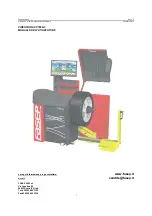
84
5-37
B
A
Operation
5.11
Optimisation / Weight
Minimisation
5.11.1 General
The unbalance optimisation is used to minimise
operation noise.
During the optimisation the tyre is fi tted on the rim in
a specifi c position based on the result of the different
unbalance measuring runs. This generally means that,
where present, axial and radial run–out and radial and
lateral forces are reduced and thus wheel running
conditions optimised. In addition, the entity of the
compensation weights required for wheel balancing
can be reduced.
If optimisation is not required, it is possible to achieve
weight minimisation.
This is possible, for example, when the rim does not
show shape defects, meaning that wheel unbalance
depends exclusively on tyre irregularities. In this case
the unbalance of the rim can be readjusted compared
to the unbalance of the tyre in a way that the they
compensate each other and a lower correction weight
is required.
5.11.2 Operating instructions for
Optimisation / Minimisation
During tyre changing operations, as required for
optimisation/weight minimisation, the wheel balancer
can be used as a conventional wheel balancer by
another operator.
To this end, press
USER (A - Fig. 5-37
) or
ESC
, thus
interrupting the weight optimisation/minimisation
programme. The electronic control unit will then store
step 3, 7, 11 of the current program, the rim dimensions
and all data measured so far.
If the operation has been interrupted by pressing
USER
, you will shift to
RIM/DATA ENTRY
screen.
If another optimisation/weight minimisation run is to be
started after an interruption, it is suffi cient to press the
key
RESTART OPT/ MIN
(
B - Fig. 5-37
), after selecting
the correct operator.
The compensation carried out by the wheel clamping
device is cancelled by starting an optimisation or
minimisation cycle.
..
..
..
.
..
. .
..
.
Содержание geodyna 7340
Страница 148: ...148 Blank Page ...
Страница 158: ...158 Blank Page ...
Страница 159: ...159 Blank Page ...

































